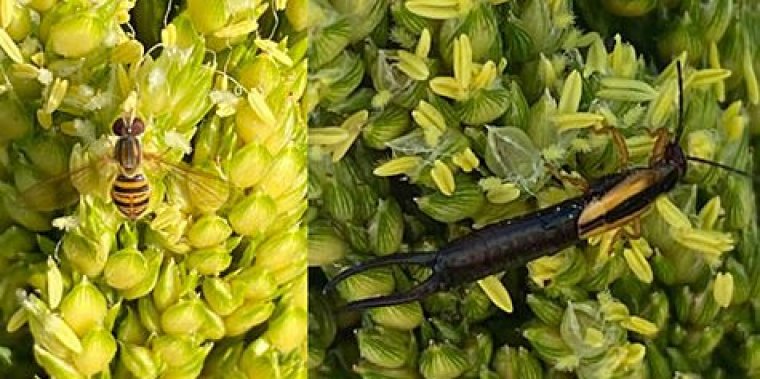| News / Science News |
Sorghum: The Unlikely Food Source for Pollinators
Sorghum bicolor, a pollen-rich grass species cultivated for grain and forage, which looks similar to corn, can be an important food source for pollinators and other beneficial insects during times when pollen and nectar are scarce.

A hoverfly (left) and an earwig (right) eat sorghum pollen. Photo: Karen Harris-Shultz
Researchers from the U.S. Department of Agriculture (USDA)'s Agricultural Research Service (ARS) and Oklahoma State University (OSU) Division of Agricultural Sciences and Natural Resources found that sorghum, commonly called milo, served as a pollen food source for bees, hoverflies, and earwigs.
Additionally, when sorghum is infested with sorghum aphids — which are known to feed on all types of sorghum — large amounts of honeydew are produced as waste.
This sugary by-product could be an alternative to nectar for pollinators and predatory insects, including flies, bees, wasps, and ants.
"Sorghum is not listed as a plant recommended to homeowners to feed pollinators despite frequent bee sightings," said Karen Harris-Shultz, a research geneticist at the ARS Crop Genetics and Breeding Research Unit in Tifton, Georgia.
"However, we found that sorghum had unintended ecological benefits. It can be a potential landscape plant for homeowners and a food source for pollinators during times of pollen and nectar shortage."
According to Harris-Shultz, people are encouraged to plant nectar-rich crops with different flowering seasons but are rarely recommended to plant wind-pollinated plants, including grasses, for supporting pollinator populations.
The study's findings show promise that grass species like sorghum can be an alternative crop for pollinators during times when other crops are not available for foraging.
According to Wyatt Hoback, a professor of entomology at OSU, pollinators are declining globally, having the potential to jeopardize the human food supply and plant diversity.
An alternative crop like sorghum could provide additional food for pollinators and inadvertently benefit predatory insects. (U.S. Department of Agriculture)
YOU MAY ALSO LIKE





